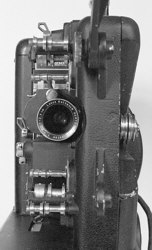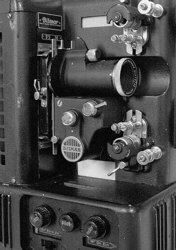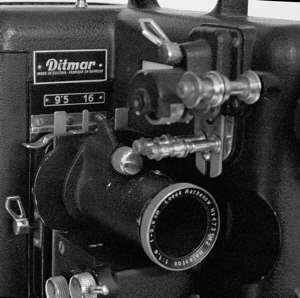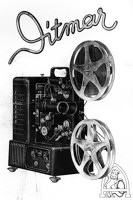3106.photography
Created 15 September 2005 ... Updated 24 December 2005
|
Ditmar 2960 Dual Gauge Projector
|
||||||||||||||||||
 This poor old projector had long been forgotten, stored in a box, in an old Viennese basement until someone decided to get rid of his grandparent's stuff. It was sold on eBay as a 'box of old photography equipment'. Luckily the seller didn't take the time to unpack the box and take pictures of every single item as these projectors usually sell for well over EUR 50. Let alone the other equipment that was in the box. On one hand lucky for me but on the other hand it's gotten more expensive since then, for what are you going to do with a fully working projector without films?
This poor old projector had long been forgotten, stored in a box, in an old Viennese basement until someone decided to get rid of his grandparent's stuff. It was sold on eBay as a 'box of old photography equipment'. Luckily the seller didn't take the time to unpack the box and take pictures of every single item as these projectors usually sell for well over EUR 50. Let alone the other equipment that was in the box. On one hand lucky for me but on the other hand it's gotten more expensive since then, for what are you going to do with a fully working projector without films?
Of course, being an old projector, with an old engine and rubber belts, there was some work to be done. Trying to get replacement belts for the dried up rubber belts turned out to be the most difficult task. The local shops got rid of all their movie equipment long ago and when there was some left, it was all for 8mm and not larger projectors. One of the shops still had a repair person that used to make new belts but he was not too keen on helping me out and it took him a long time. In the mean time I found the website of Mr Giessmann in Germany who had probably bought a few kilometers of material that can be used for belts. He now sells this stock in meter lengths which can be cut to size and when the ends are heated and melted together, you'll get a very strong, and apparently long-lasting, belt. Even though burning old dust and oil during projection of a movie makes for an authentic ambiance, it can't be good for the projector so it had to be taken apart, dusted off and the oil had to be replaced. It spins now with a lot less noise than before and it also appears to be a little faster but that might be imagination. The Ditmar projector series During the late 1920s, amateur cinema started to become popular. There had been many tries for home cinema formats before but when the French company Pathé started building a cheap line of projectors for their new neun-five (ninety-five, named after the 9.5 millimeter with of the film) film format, home cinema finally took off. The cheapest projector was a hand cranked version, the next step up was a hand cranked version that could be upgraded with an external motor and the best, and most expensive, version was just like a 'real' projector, with a built in motor. The original idea was to rent out or sell short versions of cinema movies but soon customers started asking for cameras to make their own movies.  Originally a manufacturer of lighting equipment, oil lamps and such, Ditmar stepped in the home cinema market in 1935 with a range of cameras. These cameras were the Model 2187 (8mm), Model 2190 (9.5mm) and Model 2165 (16mm). To have a complete system, this camera line was followed by a dual gauge home cinema projector line a few years later. Projectors in this line were the Model 2890 (9.5 and 8 mm), Model 2860 (8 and 16mm) and Model 2960 (9.5 and 16mm). The motors were produced in Germany and the other parts were produced in Vienna, as the end assembly. Production was stopped during WW2 but started again in the 1950s. Earlier models have black hammer lack while later models are have a 'modern' grey paint. Apparently the post-war demand was not too high or competition was stronger than before but Ditmar has not produced any cinema equipment after the late 1950s.
Originally a manufacturer of lighting equipment, oil lamps and such, Ditmar stepped in the home cinema market in 1935 with a range of cameras. These cameras were the Model 2187 (8mm), Model 2190 (9.5mm) and Model 2165 (16mm). To have a complete system, this camera line was followed by a dual gauge home cinema projector line a few years later. Projectors in this line were the Model 2890 (9.5 and 8 mm), Model 2860 (8 and 16mm) and Model 2960 (9.5 and 16mm). The motors were produced in Germany and the other parts were produced in Vienna, as the end assembly. Production was stopped during WW2 but started again in the 1950s. Earlier models have black hammer lack while later models are have a 'modern' grey paint. Apparently the post-war demand was not too high or competition was stronger than before but Ditmar has not produced any cinema equipment after the late 1950s.
These projectors are mainly interesting due to the fact that they can project two film formats. This is reached by having two separate film paths, one for the one format and the second for the other format. The projection bulb need to be slided to the correct side as well to allow for maximum light. Film speed is variable, as was common during those years. Cameras didn't have fixed film speeds so there was no need for fixed projection speeds either. The speed was simply set to what the eye would think correct. Further features are fast rewind, backward projection and the easy and user-friendly maintenance, no need to use a screw driver to perform normal maintenance operations. The oil points are clearly marked with red dots and everything opens in a way that you can easily reach and replace the belts and the light bulb. Operation is for 110 and 220 volt systems and is set, as common in this time, with a resistor plug so make sure the plug is at the correct setting before you operate the projector for the first time. |
||||||||||||||||||
|
||||||||||||||||||
|
Ditmar 2960 |
||||||||||||||||||
|
Specifications
|
||||||||||||||||||
|
||||||||||||||||||
|
||||||||||||||||||

|
All photos copyright of M. Koning 1997 - 2005
Note: Using the text or images on this site in an auction such as eBay without permission is a violation of your ebay Terms of Service. I will report you to ebay if I discover such a violation taking place. This may result in your account being cancelled. I also reserve the right to file claim for civil penalties.
Return
